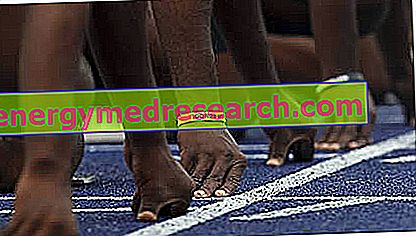Related articles: Dyshidrosis
Definition
Dyshidrosis (or dyshidrotic eczema) is a rather diffuse skin condition, characterized by the appearance of small blisters, containing transparent liquid, on the hands or feet.
This form of recurrent eczema can affect people of all ages, regardless of sex, although the most affected range appears to be between 20 and 40 years. Furthermore, dehydrosis appears more frequently during the warm months, mainly occurring on the edges of the fingers (interdigital spaces) and, sometimes, on the palm and the back of the hands or feet.
The causes of dehydrosis are not yet fully known.
The appearance of the disorder can be favored by the family predisposition and by an excess of sweating (hyperhidrosis). Furthermore, an important role in the onset of dyshidrosis is attributed to anxiety and psychosomatic disorders, as it was found that the condition often occurs after periods of tension or stress.
Other factors that can favor the onset of dehydrosis are atopy, infections and allergic reactions (both topical and systemic). There are also conditions that can facilitate the appearance of the problem, such as smoking, climatic variations, humidity and exposure to excessive heat or cold.
In some cases, then, there is no detectable cause (idiopathic dehydrosis).
Most common symptoms and signs *
- bubbles
- Erythema
- Hyperhidrosis
- Dry skin
- itch
- Pustules
- Ragadi Dita
- Follows in Feet
- Rhagades in the Hands
- Scales on the skin
- blisters
Further indications
Dyshidrosis is characterized by the appearance of round and deep vesicles, often itchy and containing a transparent serous liquid. These lesions can form, due to confluence, real bubbles.

Dyshidrosis. Image taken from Wikipedia.org
After a few days, the desquamative phase follows: the vesicles tend to reabsorb and dry up, taking on the appearance of small scales, while the outer layer of skin comes off, leaving the underlying skin exposed. Symptoms tend to worsen after contact with soap, water or irritants. In the most serious cases, areas of excoriation are formed, with cracks and thickening of the skin.
If neglected, dyshidrosis can lead to various complications, such as secondary bacterial infections, crusting and, sometimes, pustules that make daily work difficult.
Despite being a benign and non-contagious skin condition, it is advisable to consult a dermatologist for the evaluation and prescription of the most appropriate treatment.
Dyshidrosis tends to resolve spontaneously after a few weeks, but can recur punctually every spring-summer. When the disorder is in an acute phase, to relieve itching, feet and hands can be immersed in a basin of water to which one or two tablespoons of rice starch have been added and, if necessary, take antihistamine or corticosteroid drugs for a few days .
In some cases, the use of photodynamic therapy and immunosuppressants may be useful.



